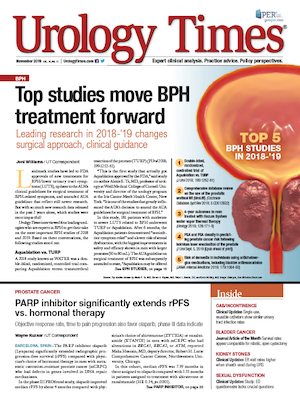Single-use, reusable catheters show similar UTI rates
A randomized trial found no difference between single-use polyvinylchloride (PVC) catheters and reused PVC catheters for patients with neurogenic bladder due to spina bifida.
Chamaiporn - stock.adobe.com

A randomized trial found no difference between single-use polyvinylchloride (PVC) catheters and reused PVC catheters for patients with neurogenic bladder due to spina bifida.
Urinary tract infections (UTIs) are a common and severe complication of spina bifida.
“Urological management includes intermittent catheterization, either clean or sterile, with either single-use or reused catheters, pharmacologic suppression of detrusor hyperactivity, and antibiotic prophylaxis. There is insufficient evidence to recommend either technique, or reutilization of catheters,” said Pedro A. Madero-Morales, MD, of Hospital Universitario Dr José Eleuterio Gonzalez in Monterrey, Mexico.
Dr. Madero-Morales presented results of a randomized study conducted along with senior author Adrián Gutiérrez-Gonzalez, MD, PhD, at the AUA annual meeting in Chicago. The study included a total of 75 patients with neurogenic bladder caused by spina bifida, randomized to intermittent catheterization with either sterile, single-use PVC catheters (37 patients) or reusable catheters (38 patients) washed with water and soap and stored in a container with a 0.5% benzalkonium chloride solution.
Also see: Combination therapy addressed in amended OAB guideline
There were 29 male and 46 female patients, and the mean age in the study was 12.7 years. Urinary symptoms began at a mean age of 2.1 years, and intermittent catheterization was started at a mean age of 4.1 years. Forty-one patients were unable to walk, and 38 patients could self-catheterize. The mean number of catheterizations per day was 3.59. Fifty percent of the cohort was receiving antimuscarinic therapy, and 54% received UTI prophylaxis. About one quarter of the cohort (23%) had bladder diverticula, and 19% had a history of vesicoureteral reflux of grade 2 or higher.
At baseline, 35.1% of the single-use group and 39.5% of the reusable group had asymptomatic bacteriuria based on a urine culture. At the follow-up assessment, 32.4% of the single-use group and 23.7% of the reusable group had bacteriuria, for an odds ratio of 0.65 (95% CI [0.23, 1.82]).
UTI was defined in the study as a positive urine culture along with fever, flank pain, malaise, and cloudy or odorous urine. The rate of UTI seen at follow-up was 35.2% with single-use catheters and 36.8% with reusable catheters, for an OR of 0.877 (95% CI [0.42, 2.76]).
Next: Inability to walk increased UTI risk in both cohortsInability to walk increased UTI risk in both cohorts
An evaluation of demographic, pharmacologic, and other parameters found that being unable to walk was associated with an increased risk of UTI in both the single-use and reusable catheter groups (p<.01). This was true as well for the absence of antimuscarinic therapy (p<.05) and for patients with a history of vesicoureteral reflux grade 2 or higher (p<.01). Other factors, including gender, age, body mass index, self-catheterization, and urodynamic parameters were not associated with any differences in the rate of UTI.
Read: ER visit rates higher when sheath used during URS
“In conclusion, we found that there were no differences between both types of catheteriziation,” Dr. Madero-Morales said. He added that these results are consistent with a Cochrane review published in 2014, though that review identified substantial heterogeneity between studies.
“Selection of catheterization technique should regard personal preferences, cost, and the ease of use. Further evidence is required to determine a standard among the techniques,” Dr. Madero-Morales said.
Tell us what you think! Send us your comments at urology_times@mmhgroup.com

Study finds disparities in management of mCSPC
April 17th 2024“These findings suggest that guideline recommended treatment intensification remains low for patients with mCSPC in both Medicare and the Veterans Health Administration, but especially for Black patients,” says Daniel J. George, MD.
